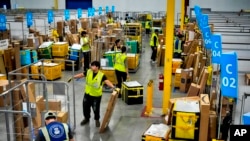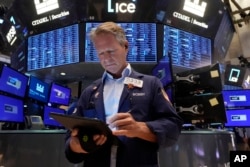With the U.S. presidential election less than three months away, Americans are being bombarded by wildly conflicting statements about the health and direction of the country's economy.
Former President Donald Trump, the Republican nominee, frequently declares that the country is approaching economic Armageddon. In recent appearances he has warned that the country is on the brink of a depression, described the economy as "broken" and claimed that rising prices are making average Americans miserable.
Allies of Vice President Kamala Harris, the Democratic presidential nominee, have pointed to falling inflation, low unemployment and rising wages to tell a story that portrays the U.S. economy as strong and getting stronger in the aftermath of the COVID-19 pandemic.
To experts and economists tracking economic data, the picture is more complicated than the description offered by either campaign, with real strengths tempered by some worrying potential problems.
"Broadly speaking, a politician is the last person I'd want to ask for an accurate assessment of where the U.S. economy stands," said Mark Hamrick, Washington bureau chief for Bankrate. "It's high season for trying to convert voters, so we need to take that with a truckload of salt."
He noted, however, that the candidates' dueling descriptions of the economy mirror "the highly polarized views of the economy that Americans themselves possess."
Exiting the pandemic
In the years that followed the pandemic, the U.S. economy recovered more quickly than most other developed economies in the world. Job growth soared, driving the unemployment rate to a 55-year low of 3.4% in January and April 2023. Investors took confidence from continued positive economic data, and the stock market began a long run toward record highs.
At the same time, Americans faced punishing inflation that, at its worst, approached 10% per year. To slow price growth to acceptable levels, the Federal Reserve began increasing its benchmark interest rate from near zero in early 2022 to the current rate of more than 5%.
Although there were concerns that the Fed's actions might trigger a recession, job growth remained strong, and inflation began to fall in 2023 and into 2024. The latest report issued this week showed that it has dropped below 3%, which is close to the Fed's target range of approximately 2%.
Recent data mixed
Data released earlier this month showed that job growth appears to have slowed significantly, but with inflation back near normal levels, the Fed is expected to begin cutting interest rates as soon as next month, which could have the effect of boosting hiring.
And while prices for consumer goods remain significantly elevated, the low unemployment rate has been driving wage increases, particularly among low-wage Americans. In the past year, the rate of wage growth has exceeded the rate of inflation, helping to restore some of Americans' lost purchasing power.
While the stock market is not a reliable proxy for the state of the economy on any given day, volatility has spiked in recent weeks, with many investors nervous that months of relatively steady increases make some sort of correction inevitable. Two weeks ago, stocks suffered a major rout, only to soar back to near-record highs this week.
Positive outlook, with caveats
"The economy has been very strong for a couple of years now, in terms of both economic growth, the employment situation, labor force participation, real wage growth, basically any indicator that one would care about," said Kimberly Clausing, a nonresident senior fellow with the Peterson Institute for International Economics.
"With any economy, there's a high degree of uncertainty, and there are factors beyond your control, but I think there's no reason to suspect that this next year won't be a good year," Clausing told VOA.
In an email exchange with VOA, economist Desmond Lachman, a senior fellow with the American Enterprise Institute, agreed that the economy has performed well recently.
"The economy has held to the Federal Reserve's monetary policy tightening better than expected, although it is now showing clear signs of slowing," he said.
"Inflation has come down markedly towards the Fed's 2% inflation target, yet output growth has held up and the unemployment rate remains close to its postwar low," Lachman said. "It looks like the Fed now has room to start cutting interest rates beginning in September."
Lachman also noted some possible areas of concern.
"Two issues that cloud the long-term outlook are the country's poor public finances and its seeming drift towards protectionism," he said. "It is of concern that in the election campaign neither candidate is addressing the question of how to put the country's public finances on a more sustainable path. Indeed, they appear to be making promises that could worsen an already troubling fiscal position — Kamala Harris through public spending promises, and Donald Trump through tax cuts."
Both Clausing and Lachman warned that a major wild card is trade policy. Trump has threatened to impose heavy tariffs on imports. Economists worry that doing so could cause inflation to spike again and could trigger retaliatory tariffs from the U.S.'s trading partners.































